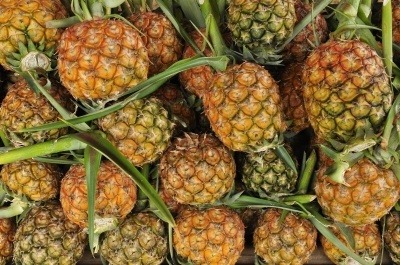
The pineapple retains its position as one of the world’s favourite fruits. It has long been one of the most popular of the non-citrus tropical and subtropical fruits, largely because of its attractiveness, flavour and refreshing sugar-acid balance (Arthey, 1995). It is exceptionally juicy with a distinctive flavour that retains a mix of sweetness with acidity or tartness. It has certainly moved on from being served as fritters with ham or offered from the can as rings for parties and speared as a chunk by a cocktail stick with a piece of cheddar.
The pineapple (Ananas comosus [L.] Merr.) is often referred to as the ‘King of Fruit’. It is grown extensively throughout the tropics and sub-tropics such as Hawaii, Philippines, the Caribbean, South-East Asia, Australia, Mexico, Kenya and South Africa.
The plant is a bromeliad which is one of those rare members of the family that has also found food use. It is generally grown in warm sub-tropical climates.
It is generally processed by canning when not available as a fresh fruit.
Nutrition of a Pineapple
Nutritionally (Duke, 1983; Samson, 1986), 100 g pineapple contains 47-52 calories, 85.3-87.0 g water, 0.4-0.7 g protein, 0.2-0.3 g fat, 11.6-13.7 g total carbohydrate, 0.4-0.5 g fibre, 0.3-0.4 g ash, 17-18 mg calcium, 8-12 mg phosphorus, 0.5 mg iron, 1-2 mg sodium and 125- 146 mg potassium. The fruit also contains 12-15 % sugars of which two-third is in the form of sucrose and the rest are glucose and fructose. 0.6-1.2 % of pineapple is acid of which 87 % is citric acid and 13 % is malic acid. The pH of the juice is acidic, which is 3.71 and the acidity percentage is 53.5 %.
The composition of the fruit varies with the processing season which is usually from March to April, the degree of handling, processing and storage.
Pineapple Juice is one of the Best Juices for Soothing The Throat
Coughs and colds are the order of the day in the winter months. Pineapple juice appears to be a remedy for suppressing coughs. Evidence has been developing to show that an enzyme in the juice called bromelain may be the reason why pineapple juice has such a benefit and loosens mucus in the throat. Eating a slice of pineapple can do wonders for ameliorating soreness. Drinking some pineapple juice (3.5 oz.) three times a day can also help.
Here we show three ways to prepare pineapple juice drinks which can help alleviate the soreness from coughing.
Drink No. 1: Pineapple juice and honey
You only need two ingredients to prepare this drink which is pineapple juice and honey. Take half a cup of warm pineapple juice and one tablespoon of honey in a bowl. Mix both of them well and drink it when it is slightly warm. Both honey and pineapple will soothe your throat and provide relief from cough.
Drink No. 2: Pineapple juice, honey, salt and pepper
Take a cup of pineapple juice and add half tablespoon of honey, a pinch of salt and pepper. Mix all these ingredients properly and drink this mixture three times a day.
Drink No. 3: Pineapple juice, honey, ginger, cayenne pepper, and salt
This a traditional remedy for maximal relief from cough and cold. Put one cup of pineapple juice, 1 tablespoon honey, 1 tablespoon chopped ginger, 1 pinch salt, and a little cayenne pepper in a blender. Blend all the ingredients and drink a quarter of this mixture three times every day to get rid of a rasping sore throat.
Whilst pineapple juice might be a palatable way of taking bromelain, there are supplements available of just bromelain which help. It’s worth remembering that bromelain is not to be taken by anyone on blood thinning drugs. care also has to be taken when taking very powerful antibiotics like amoxicillin because it promotes the absorption of such drugs. Thee is no evidence though that you cannot drink pineapple juice if you are taking blood thinners or such antibiotics.
Obtain your bromelain supplements here
Leaf Extracts From Pineapple Could Have Antidiabetic Potential
There is a piece of research which showed that an ethanolic leaf extract at a dose of 400 mg/kg improved the insulin sensitivity and glucose uptake in a cell line called insulin resistant HepG2 (Xie et al., 2005). There doesn’t seem to be much more follow-up research on this one but it would be worth checking further.
[Please note we are an affiliate marketing partner and will make a sales commission if you purchase any items through our affiliate links. Please read our affiliate disclosure]
References
Arthey, D. (1995). Food Industries Manual. In: Fruit and Vegetable Product. London. P. 151
Bartolomé, A. P., Rupérez, P. and Fúster, C. (1995). Pineapple Fruit: Morphological Characteristics, Chemical Composition and Sensory Analysis of Red Spanish and Smooth Cayenne Cultivars. Food Chem. 53 pp. 75 – 79.
Duke, J. A. (1983). Ananas comosus (L.) Merr. In: Handbook of Energy Crops.
Samson, J. A. (1986). Tropical Fruits. 2nd ed. New York: Longman Inc.
Xie, W., Xing, D., Sun, H., Wang, W., Ding, Y., & Du, L. (2005). The effects of Ananas comosus L. leaves on diabetic-dyslipidemic rats induced by alloxan and a high-fat/high-cholesterol diet. The American Journal of Chinese medicine, 33(01), pp. 95-105 (Article).
Can you write about other fruit and why was this the first one ?
Hi Tom,
This was the first simply because I happened to have written the post for a web-site I was working on but didn’t add. I have others which will be included to reflect those earlier years. Just look out for them !